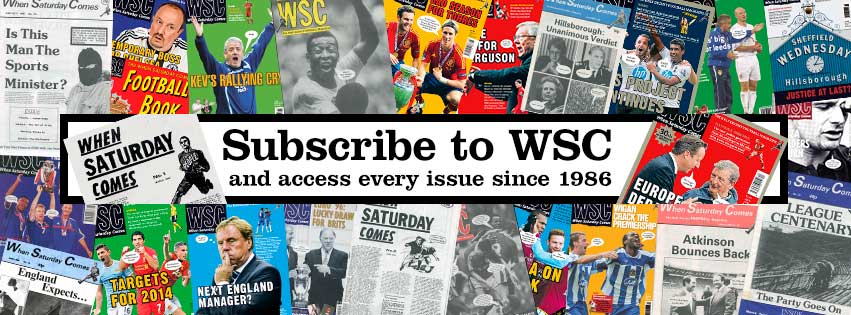
From tricky wingers to reliable shot-stoppers, there’s a reassuring familiarity to the pen pics in a non-League match programme – and one archetype that towers above the rest
28 May ~ The warm mid-afternoon sun was still glinting from the polished granite in the graveyard behind the far goal when the centre-forward cut across a defender in the box and went down in a Catherine wheel whirl of arms and legs.
The match official, a short, wombat-shaped man of the sort who might delight the nation by dancing unexpectedly sinuously to Drake in a building society advert, sent off the offender without hesitation. The incident provoked one of those passive arguments that periodically break out between non-League fans following controversy.
“Never a red card, that,” announced one fan of the defending side loudly enough to rattle putty from the windows of the groundkeeper’s hut. “Aye, he was heading away from the goal,” another commented at equal volume, as the defender departed.
On the other side of the committee men’s seats that substitute for fencing and a cordon of hi-vis stewards at this level of the game, rival fans heard this and began their own noisy dialogue. “A clear scoring opportunity denied, there.” “Defo. He made the ref’s decision easy for him, the defender.”
Like an unhappily married couple addressing each others’ faults through a counsellor no words were exchanged directly, but everyone present knew where they were aimed. The sniping continued intermittently throughout the afternoon until both groups were so entangled in their mutual bitterness you suspected they’d head off to Ikea together after the final whistle and continue to bicker vindictively over offsides and shoulder-to-shoulder challenges amid the home office furniture and the scent of meatballs.
I distracted myself from the acrimony by reading the player profiles in the programme. There was the usual warm familiarity about them. No matter where you are in the country a common thread runs through any team below the national level. Without exception every squad has at least one of the following: a versatile defender who can play across the whole of the backline; a fast, tricky winger whose direct style can unlock defences; a midfielder who likes a tackle, wears his heart on his sleeve and is a favourite of the fans; an experienced, no-nonsense, strong, imposing centre-back who is the lynchpin of the side. (Lynchpin is one of those words you rarely hear outside of football, like “sumptuous” and “aplomb”.)
There are other descriptions that crop up pretty regularly too: highly rated goalkeepers who are reliable shot-stoppers, midfielders who “add energy” and have “an eye for goal”, and an overseas player with an unlikely surname (Castrate was my favourite) who inevitably offers “something a little different from the bench”. But it’s the first four that are universal.
The old-fashioned centre-half is the most common of the lot, as inevitable as a St George flag fluttering over the allotments. Every side has one. Generally he is the sort of walk-tall, chin-thrust-out, firkin-chested fellow who looks like he’s about to slam through the doors of a Wild West saloon and take vengeance on the men who burned his barn down. Yet there are plenty of times when he is quite the opposite of resolute and rock-like. Sometimes, for instance, he is long-haired, bearded, tanned and louche with the studied indifference of a Monte Carlo playboy throwing in the last of his chips. He has time and elegance. You briefly imagine him hanging out with César Luis Menotti, flicking ash into the technical area and plotting the defeat of autocracy through flair and an avoidance of barbers. It is reverie that ends after 20 minutes when he yells a string of expletives at an opponent.
On other occasions the rugged centre-back is slender as a heron, with thinning hair and swollen knees and every time the wet ball smacks off his moon-coloured thighs you suffer an empathetic sting and suck air in through your teeth. Yet still the programme proclaims that he is durable as granite.
Because in the end it’s not really about how he is, it’s about how we dream him to be. The presence of the no-nonsense centre-back is a comfort to us all. So sometimes we have to project a little, reshape him to our needs.
We may never have seen him do such things, but in our mind we can imagine him, late on, the floodlights gleaming from his sweating brow, his side in desperate need of an equaliser, throwing himself across the penalty area through a threshing machine of boots and elbows, to head a corner into the opposition net.
Or defending a lead in the dying moments of a cup tie. Exhorting his team-mates with roars and shoulder slaps, the opposition’s crosses drawn to his forehead as if by some magnetic force, to be splatted away to the halfway line with such power.
The old-school centre-back is a big man filled with self-assurance and a firm sense of right and wrong. In victory he is generous to those weaker than himself, in defeat he sinks briefly to his knees, then rises once more. He is not only the beating heart of the defence, the soul of the team, he is the Dad we always wanted. Harry Pearson
Illustration by Tim Bradford with images from Colorsport/PA Photos
This article first appeared in WSC 387, June 2019. Subscribers get free access to the complete WSC digital archive – you can find out more here
